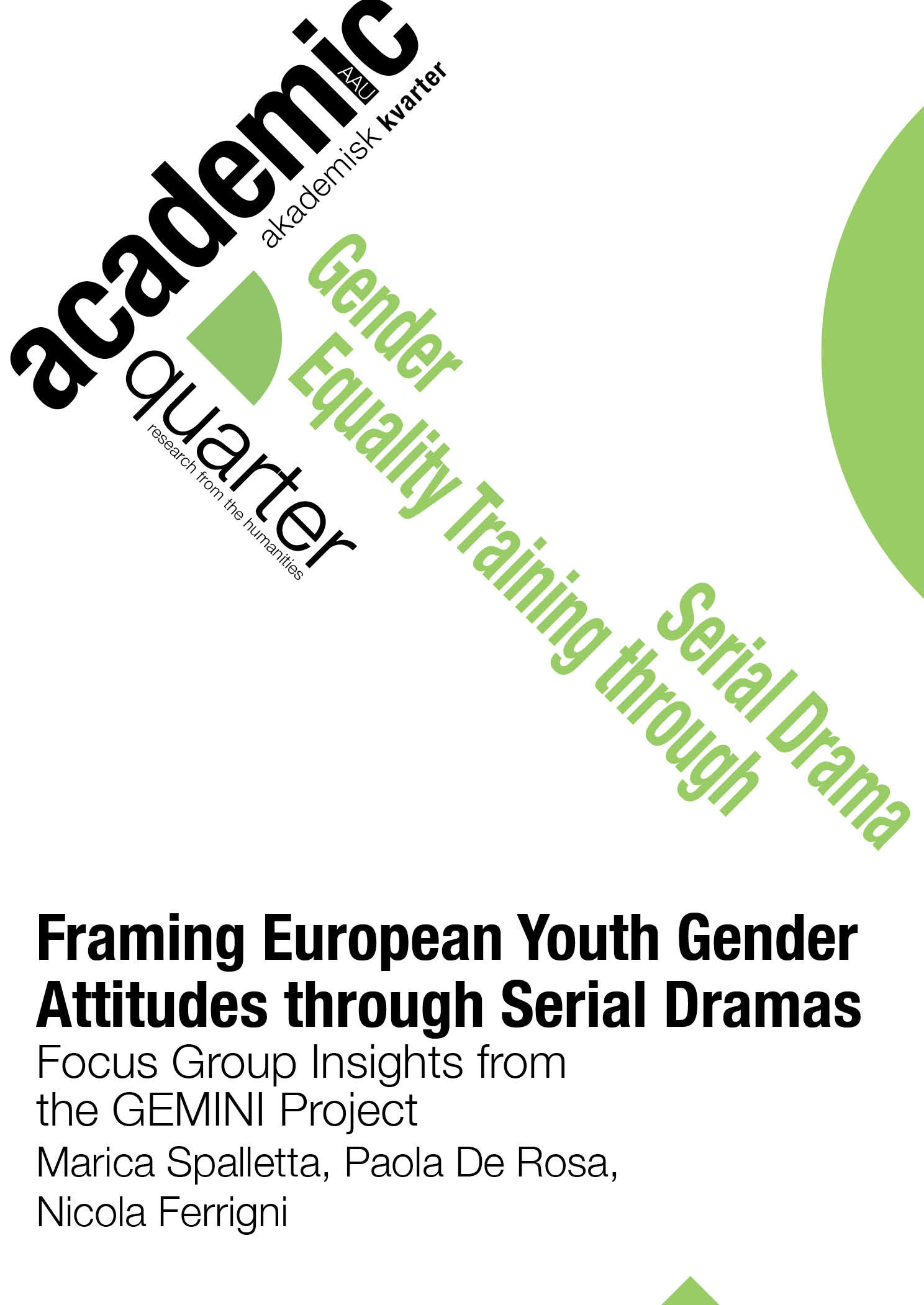Abstract | Abstract
The wide universe of serial drama acts both as mirror and shaper of young adults’ perceptions and attitudes towards social issues, also fostering their growing interest in gender-related ones. Drawing from the European project GEMINI-Gender Equality through Media Investigation and New training Insights (CERV-2022-GE), this study provides the insights from the qualitative research phase, consisting of 15 focus groups interviews carried out in 4 countries (Denmark, Italy, Ireland and Romania) with the aim of detecting the interplay between serial narratives, gender issues and European young adults. The main findings show complex dynamics between media consumption and youth views, revealing how serial dramas can challenge stereotypes and promote conversations around gender topics, though they tend to reinforce existing attitudes rather than change views or behaviours.
Referencer
Andò, Romana, and Danielle Hipkins. 2022. “Teen Identity, Affect and Sex in Rome. Italian teen girl audiences and the dissonant pleasures of Netflix’s underage prostitution drama Baby.” Studi culturali 2:207–232.
Ang, Ien. 1991. Desperately Seeking the Audience. London: Routledge.
Babbie, Earl R. 2013. The practice of social research. Belmont: Wadsworth Thomson Learning.
Bengesser, Cathrin, Paola De Rosa, Pia Majbritt Jensen, and Marica Spalletta. 2023. “Audiences of popular European television crime drama: A nine-country study on consumption patterns, attitudes and drivers of transcultural connection.” European Journal of Communication 38(2): 148–165. https://doi.org/10.1177/02673231221112535
Bennett, W. Lance, and Suanto Iyengar. 2008. “A new era of minimal effects? The changing foundations of political communication.” Journal of Communication 58(4): 707–731. https://doi.org/10.1111/j.1460-2466.2008.00410.x
Berger, Peter and Thomas Luckmann. 1966. The Social Construction of Reality: A Treatise in the Sociology of Knowledge. New York: Doubleday & Company.
Bondebjerg, Ib, Eva Novrup Redvall, Rasmus Helles, Signe S. Lai, Henrik Søndergaard, and Cecilie Astrupgaard. 2017. Transnational European Television Drama: Production, Genres and Audiences. London: Palgrave Macmillan. https://doi.org/10.1007/978-3-319-62806-6
boyd, danah. 2014. It’s Complicated: The Social Lives of Networked Teens. New Haven: Yale University Press.
Corbetta, Piergiorgio. 2014. Metodologia e tecniche della ricerca sociale. Bologna: il Mulino.
Couldry, Nick. 2003. Media Rituals: A Critical Approach. London: Routledge.
Coviello, Massimiliano, Paolo De Rosa, Valentina, Re, and Marica Spalletta. 2021. “Scelgo dunque sono? L’esperienza Netflix nel racconto degli utenti.”. Imago. Studi di cinema e media 23(1): 57–73.
Cresswell, John W., and Vicki L. Plano Clark. 2015. Designing and Conducting Mixed Methods Research. Thousand Oaks (CA): Sage.
Cuklanz, Lisa M., and Ali Erol. 2021. “The Shifting Image of Hegemonic Masculinity in Contemporary US Television Series.” International Journal of Communication 15: 545–562.
Dove-Viebahn, Aviva. 2024. “Controlling the Narrative, Examining the Self: The Unruly Femme Subjectivity of Fleabag.” Sexualities 27(8): 1401–1414. https://doi.org/10.1177/13634607231157072
Dunleavy, Trisha. 2017. Complex Serial Drama and Multiplatform Television. London: Routledge. https://doi.org/10.4324/9781315682310
EIGE. 2023. Gender Equality Index 2023. Towards a green transition in transport and energy. Publications Office of the European Union.
European Commission. 2020. A Union of Equality: Gender Equality Strategy 2020-2025. Brussels 5 March 2020.
Farci, Manolo, and Marco Scarcelli. eds. 2022. Media digitali, genere e sessualità. Milano: Mondadori.
Hall, Stuart. 1973. Encoding and Decoding in the Television Discourse. Birmingham: Centre for Contemporary Cultural Studies.
Hall, Stuart. 1980. Encoding / Decoding. In Culture, Media, Language, edited by Stuart Hall, Dorothy Hobson, Andrew Lowe, and Paul Willis. London: Hutchinson.
Heim, Julia. (2020). “Italian LGBTQ Representation in Transnational Television.” Journal of Italian Cinema & Media Studies 8(2): 189–203. https://doi.org/10.1386/jicms_00016_1
Hansen, Kim Toft. ed. 2024. D3.1 – Knowing the gender equality issue through the lens of TV series. Available at: https://gemini.unilink.it/wp-content/uploads/2024/11/D3.1-reduced-2.pdf
Hill, Annette. 2019. Media Experiences: Engaging with Drama and Reality Television. New York: Routledge. https://doi.org/10.4324/9780203103531
Jenkins, Henry. 2006. Convergence Culture: Where Old and New Media Collide. New York: New York University Press.
Jenkins, Henry, Sam Ford, and Joshua Green. 2013. Spreadable Media: Creating Value and Meaning in a Networked Culture. New York: New York University Press.
Katz, Elihu, and Paul Lazarsfeld. 1955. Personal Influence: The Part Played by People in the Flow of Mass Communications. New York: The Free Press.
Klapper, Joseph T. 1960. The Effects of Mass Communication. New York: The Free Press.
Krueger, Richard A., and Mary Anne Casey. 2015. Focus Groups: A Practical Guide for Applied Research. Thousand Oaks: SAGE.
Livingstone, Sonia. 2003. The Audience Studies Reader. London: Routledge.
Lobato, Ramon. 2019. Netflix Nations: The Geography of Digital Distribution. New York: New York University Press.
Marghitu, Stefania. 2021. Teen tv. London: Routledge. https://doi.org/10.4324/9781315229645
Mittell, Jason. 2015. Complex TV: The Poetics of Contemporary Television Storytelling. New York: New York University Press.
Papacharissi, Zizi. 2014. Affective Publics: Sentiment, Technology, and Politics. Oxford: Oxford University Press. https://doi.org/10.1093/acprof:oso/9780199999736.001.0001
Pariser, Eli. 2011. The Filter Bubble: What The Internet Is Hiding From You. London: Penguin.
Re, Valentina, and Marica Spalletta. 2023. “Unsuitable Jobs for Women. Women’s Behind-the-Scenes Employment and Female On-Screen Representation in Italian TV Crime Drama.” Comunicazioni sociali 1: 82–97.
Scarcelli, Marco, Despina Chronaki, Sergio Villanueva Baselga, and Sara De Vuyst, eds. 2021. Gender and Sexuality in the European Media: Exploring Different Contexts Through Conceptualisations of Age. London: Taylor & Francis. https://doi.org/10.4324/9780367808792
Scolari, Carlos A. 2019. “Beyond the myth of the ‘digital native’ adolescents, collaborative cultures and transmedia skills.” Nordic journal of digital literacy 14(3/4): 164–174. https://doi.org/10.18261/issn.1891-943x-2019-03-04-06
Sulimma, Maria. 2020. Gender and Seriality: Practices and Politics of Contemporary US Television. Edinburgh: University Press. https://doi.org/10.3366/edinburgh/9781474473958.001.0001
Spalletta, Marica. ed. 2024. D3.2. – Understanding Young Adults’ Perceptions and Detecting Teachers’ and Trainers’ Awareness. Available at: https://vbn.aau.dk/files/762593573/D3.2-Final-report.pdf
Sunstein, Cass. 2001. Republic.com. Princeton-Oxford: Princeton University Press.
Sunstein, Cass. 2007. Republic.com 2.0. Princeton: Princeton University Press.
Sunstein, Cass. 2017. #Republic: Divided Democracy in the Age of Social Media. Princeton: Princeton University Press. https://doi.org/10.1515/9781400884711
van Dijck, José, Thomas Poell, and Martijn de Waal. 2019. The Platform Society: Public Values in a Connective World. Oxford: Oxford University Press. https://doi.org/10.1093/oso/9780190889760.001.0001

Dette værk er under følgende licens Creative Commons Navngivelse – Ikke-kommerciel – Ingen Bearbejdede Værker (by-nc-nd).
Copyright (c) 2025 Marica Spalletta, Paola De Rosa, Nicola Ferrigni
